
Tokyo-Miyakejima Model Plan for 3 days and two nights
(Reserved taxies will be available)
| 22:30 | Depart Takeshiba Passenger Terminal Spend the night on-board vessel. |
| 05:00 | Arrive at Miyakejma |
| Morning: | Birdwatch around Tairoike and visit Akakokko Station |
| Afternoon: | Birdwatch and visit the traces of volcanic eruptions around Shin-myo ike(pond), Toga Jinja (shrine) ,Toga-hama (beach), Ako Primary School, Ako Middle School, Shiitori Jinja (shrine),Sanshichi-yama and the backside of the high school. |
| Evening/Night: | Hear the calls of Brown Hawk-owls AOBAZUKU Ninox scutulata. The calls can be heard at both inns, "Snapper" and "Nippanaso." |
| Early morning: | Birdwatch near the lodging. Izu Thrushes can often be seen at the residential area. |
| Morning: | Watch Pleske’s Grasshopper-warblers at Izu-misaki (cape). Afterwards go to Yakushi-do temple hall to observe subspecies of Japanese Robins and other birds. |
| 13:35: | Depart Miyakejima for Tokyo. The time of departure depends on the type of the vessel used and conditions of the sea. While on board the vessel you will watch Streaked Sheawaters O-MIZUNAGIDORI Calonectris leucomelas and other birds. |
| 19:45: | Arrive at Takeshiba Passenger Terminal. The arrival time depends on the type of the vessel used and conditions of the sea. |
Birds which can be seen in Miyakejima in each season are as follows. In spring and in autumn, about 60 species of migrant birds pass through the island which serves as a stopover for these birds.
| Milvus lineatus Black-eared Kite Tobi | Columba janthina Japanese Wood-pigeon Karasu-bato |
| Streptopelia orientalis Oriental Turtle-dove Kiji-bato | Ninox scutulata Brown Hawk-owl Aoba-zuku |
| Dendrocopos kizuki matsudaira (Japanese Pygmy Woodpecker) Miyake-kogera | Ixos amaurotis Brown-eared Bulbul Hiyodori |
| Lanius bucephalus Bull-headed Shrike Mozu | Troglodytes troglodytes mosuke (Wren or Winter Wren) Mosuke-misosazai |
| Erithacus akahige tanensis (Japanese Robin) Tane-komadori | Monticola solitarius Blue Rock-thrush Iso-hiyodori |
| Turdus celaenops Izu Thrush Akakokko | Cettia diphone Japanese Bush-warbler Uguisu |
| Parus varius owstoni (Varied Tit) O-suton-yamagara | Parus major Great Tit Shiju-kara |
| Zosterops japonicus stejnegeri (Japanese White-eye) Shichito-mejiro | Emberiza cioides Meadow Bunting Hojiro |
| Carduelis sinica Grey-capped Greenfinch Kawara-hiwa | Passer montanus Tree Sparrow (or Eurasian Tree Sparrow) Suzume |
| Corvus macrorhynchos Large-billed Crow Hashibuto-garasu |
| Synthliboramphus wumizusume Japanese Murrelet Kanmuri-umisuzume | Calonectris leucomelas Streaked Shearwater O-mizunagidori |
| Cuculus poliocephalus Little Cuckoo Hototogisu | Apus pacificus Fork-taied Swift Amatsubame |
| Hirundo rustica House swallow (or Barn Swallow) Tsubame | Locustella pleskei Pleske's Grasshopper-warbler Uchiyama-sennyu |
| Phylloscopus ijimae Izu Leaf-warbler Iijima-mushikui |
| Phoebastria immutabills Laysan Albatross Ko-ahodori | Phalacrocorax capillatus Japanese Cormorant Umi-u |
| Phalacrocorax pelagicus Pelagic Cormorant Hime-u | Aix galericulata Mandarin Duck Oshidori |
| Anas platyrhynchos Mallard Ma-gamo | Anas strepera Gadwall Okayoshi-gamo |
| Anas penelope Wigeon (or Eurasian Wigeon) Hidori-gamo | Anas acuta Pintail (or Common Pintail) Onaga-gamo |
| Aythya fuligula Tufted Duck Kinkuro-hajiro | Aythya marila Scaup (or Greater Scaup) Suzu-gamo |
| Pandion haliaetus Osprey Misago | Accipiter gentilis Goshawk (or Northern Goshawk) O-taka |
| Buteo buteo Buzzard (or Common Buzzard) Nosuri | Falco peregrinus Peregrine Falcon Hayabusa |
| Fulica atra Coot (or Common Coot) O-ban | Larus schistisagus Slaty-backed Gull O-seguro-kamome |
| Larus crassirostris Black-tailed Gull Umineko | Motacilla alba White Wagtail Haku-sekirei |
| Anthus rubescens American Pipit Tahibari | Phoenicurus auroreus Daurian Redstart Jo-bitaki |
| Turdus pallidus Pale Thrush Shirohara | Turdus naumanni Dusky Thrush Tsugumi |
| Emberiza spodocephala Black-faced Bunting Aoji | Emberiza variabilis Grey Bunting Kuroji |
| Fringilla montifringilla Brambling Atori | Carduelis spinus Siskin (or Eurasian Siskin) Ma-hiwa |
| Pyrrhula pyrrhula Bullfinch (or Eurasian Bullfinch) Uso |
| Puffinus tenuirostris Short-tailed Shearwater Hashiboso-mizunagidori | Sula leucogaster Brown Booby Katsuodori |
| Bubulcus ibis Cattle Egret Ama-sagi | Casmerodius albus Great Egret Dai-sagi |
| Mesophoyx intermedia Intermediate Egret Chu-sagi | Ardea cinerea Heron (or Grey Heron) Ao-sagi |
| Butastur indicus Grey-faced Buzzard Sashiba | Pluvialis fulva Pacific Golden Plover Munaguro |
| Tringa glareola Wood Sandpiper Takabu-shigi | Tringa incanus Wandering Tattler Meriken-Kiashi-shigi |
| Heteroscelus brevipes Grey-tailed Tattler Kiashi-shigi | Numenius phaeopus Whimbrel Chushaku-shigi |
| Cuculus optatus Oriental Cuckoo Tsutsudori | Upupa epops Hoopoe Yatsugashira |
| Motacilla cinerea Grey Wagtail Ki-sekirei | Acrocephalus arundinaceus Great Reed-warbler O-yoshikiri |
| Ficedula narcissina Narcissus Flycatcher Ki-bitaki | Cyanoptila cyanomelana Blue-and-white Flycatcher O-ruri |
Among others, it is particularly worth noting that the birds mentioned above include several species designated in the Red Data Book. We will give below brief explanations of representative species.
The birds belong to a thrush group seen all the year round in Miyakejima. They cannot be seen in the mainland. They live in the forests and the margins of forests in low and mountainous areas. Izu Thrush resembles Brown-headed Thrush AKAHARA Turdus chrysolaus in appearance but the head of a male is more blackish, while a female's back and underpart are more reddish than those of Brown-headed Thrush. The birds forage on insects and earthworms on the ground. They breed in the Izushoto islands excluding Torishima, and the Tokararetto islands. In Miyakejima, due to increased predation pressure by introduced weasels and loss of habitats caused by the eruptions of the volcano in 2000(Endangered, EN).
The birds fly over to the grasslands on the Izushoto islands as summer birds. They sing "Chirrr cheka,cheka" perching on dead stalks or sometimes in flight. They forage on insects and spiders. The eruptions of the volcano in 2000 destroyed the grasslands near the summit of the island where the number of individuals is the largest. Presently, the birds are most abundantly seen in the grassland of Izu-misaki, and some birds are also seen at some grasslands along other beaches such as Toga-hama (Endangered, EN).
The birds come over to the Izushoto islands and the Tokararetto islands as summer birds. They are not seen in the mainland. They live in thick bushes and forests foraging mainly on insects and spiders. They can be observed in the forests around Tairo-ike, Izu-misaki and Yakushi-do. After the eruptions of the volcano in 2000, they can be seen even in open forests which were created as a result of trees dying away from volcanic gas (Vulnerable, VU).
The bird is a small seabird that breeds on some of islands near Japan. The estimated number of individuals is as small as about 5,000. They are seen breeding in a rock reef called Sanbondake (Ohnohara-jima island) 10km west of Miyakejima. Sanbondake was once used for the live-fire military exercises of the United States Armed Forces, and the history tells us the late Dr. Jack Moyer pleaded with the president of the United States at the time directly for the discontinuation of the firing with success. Although the birds can rarely be seen from the shore, they can be seen almost certainly from on board vessel from April to mid May. At some lodges watching boats are available (Vulnerable, VU).
The bird is a resident bird at seashores and islands covered with thick evergreen broadleaved forests in the warm regions (Izushichito islands, Okinawashoto islands and Amamioshima island, etc). The voice is "wuwoo, wuwoo". The body is black with metallic luster of purplish red color on the top of the head, the neck and back, and with greenish-luster on the throat and breast (Near Threatened, NT).
When you see a tit in Miyakejima, watch carefully the colors of its plumage. Different from other subspecies of Varied Tit in Japan, its forehead, cheeks and upper-breast are reddish brown. The body is a little bigger than other subspecies of Varied Tit. The birds breed in Miyakejima, Mikurajima and Hachijojima on the Izushoto islands (Endangered, EN).
Subspecies of Japanese Pygmy Wood Pecker live in forests in lowlands and mountainous areas. The birds move about busily on branches and trunks of trees foraging on spiders and insects. They are usually quiet, with an occasional characteristic " girk". The bird breeds on Miyakejima and Mukojima-island/s.
Subspecies of Winter Wren. They inhabit low and mountainous forests along runoffs and valleys. Hopping around dark forest floors and bushes, they forage on insects and spiders. The bird is only found in the Izushoto islands. The body is small and round generally dark in color frequently raising its short tail.
They live in forests and bamboo bushes in low and mountainous areas. They are abundant in evergreen broad-leaved forests in warm regions. The bill is a little longer than that of other subspecies of Japanese White-eyes.
They live in mountain forests covered with bamboo grass. The birds forage on insects and earthworms on the ground. The bird is a resident bird in the Izushoto islands and Yakushima island. They breed in coastal forests in southern Izushoto islands including Miyakejima. Underparts of adult male have no dark breast band.
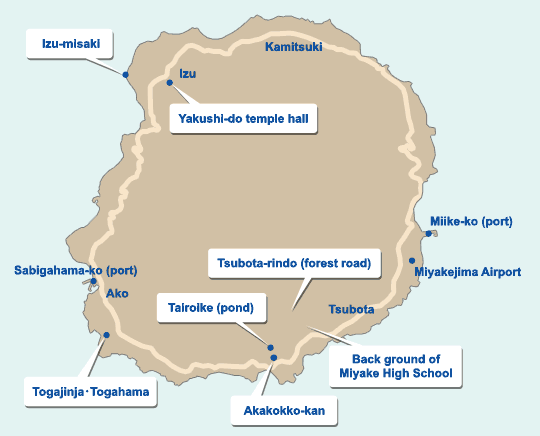
Major birding sites are shown in the following chart. We recommend you to visit the island between April and June because you can watch summer birds endemic to Miyakejima. Mid-summer is not recommendable due to a large number of tourists.
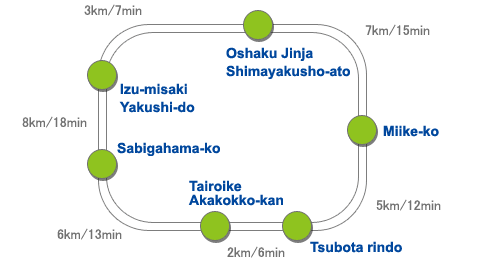
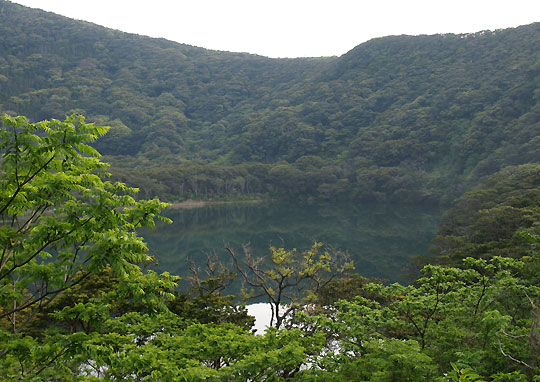
| Nearest Bus stop: | Tairoike |
| Necessary Time: | At least one hour |
| Notes: | Lavatory and rest station available |
Tairoike is located in the south of the island and one of the major birdwatching sites of Miyakejima. The pond is thought to be a volcanic crater lake made by eruptions about 2500 years ago. Trees such as the huge SUDAJII are still found in large numbers even after volcanic eruptions in 2000. You can watch a lot of wild birds including Izu Thrush, Izu Leaf-warbler and Japanese Wood Pigeon here. It is no exaggeration to say that the density of Izu Leaf-warbler, especially between April to June here, is the highest on the globe.
In summer, you can often hear the song of Little Cuckoo HOTOTOGISU Cuculus poliocephalus, which sings as ”Kyo-Kyo-Kyo-Kyo-Kyo-Kyo”. The call of Brown Hawk Owl sounds as follows ”Hoh-Hoh, Hoh-Hoh“The call of Collared Scops-owl O-KONOHAZUKU Otus lempiji semitorques can rarely be heard. Ducks such as Mandarin Duck OSHIDORI Aix galericulata winter here.
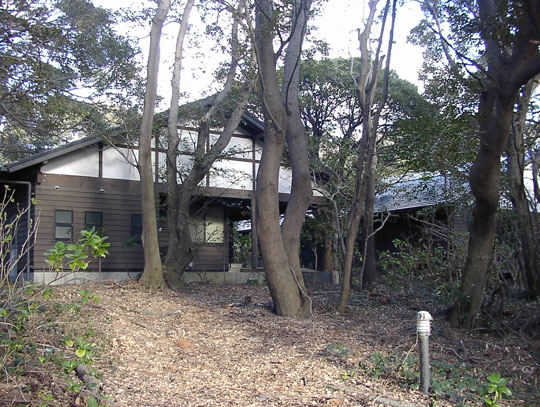
| Nearest Bus stop: | Tairo-ike Iriguchi (entrance) |
Akakokko-kan is located near Tairoike. This is a nature observation facility which was built in 1993 in order to let more people know about the rich nature of Miyakejima and has been operated by Miyakemura village. Rangers from the Wild Bird Society of Japan (WBSJ) are always here, giving information on nature to visitors, organizing nature tours and conducting surveys and researches. Inside the building, there is an exhibition section for the nature of the island (birds, marine life and volcano), and books, field guides and other information materials on Miyakejima are available to visitors.
Akakokko-kan is in a forest of SUDAJII, so you can watch various birds from inside, such as subspecies of Japanese Robin and Winter Wren as well as Izu Thrush, Izu Leaf-warbler, subspecies of Japanese White-eye, subspecies of Varied Tit and Great Tit, SHIJU-KARA Parus major, which often come to a bird bath. You are always welcome to our station!
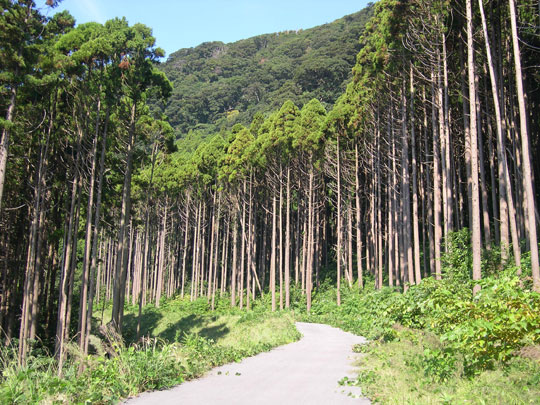
| Nearest Bus stop: | Koukou-mae (Starting point of the bus line) |
| Necessary Time: | 1 - 2 hours |
| Notes: | No lavatory and resting places |
The back of Miyake High School is an easily accessible birding site from Tsubota. The site is a vestige of an explosion crater created by eruptions in olden time, and its surrounding is composed of steep slopes. Walking along a path on the right side of the bus stop for about a few hundred meters and then, you will reach a forest of the OBA-YASHABUSHI. There are no houses here. Walk into the forest further and you will see Izu Thrush, Izu Leaf-warbler and subspecies of Varied Tit. About one kilometer from the bus stop, you will come to a mudslide control dam, which was built after the eruptions in 2000 in order to protect residents from the volcanic mudflow. You will hear songs of subspecies of Japanese Robin and Japanese Wood Pigeon from surrounding slopes.
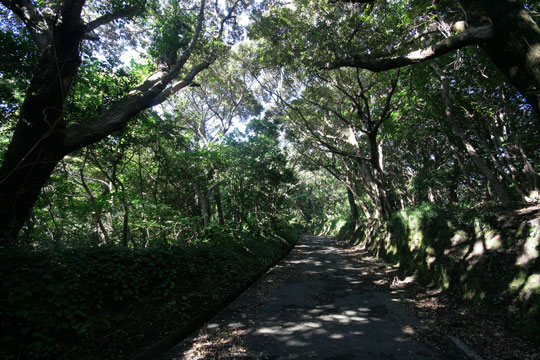
| Nearest Bus stop: | Norin Godo Chosha (Government office) |
| Necessary Time: | about 2 hours |
| Notes: | No lavatory and resting places |
You can see typical forests here because the site was not affected by the eruptions in 2000. Walking up the slope from the entrance of the forest road, you will reach forests of the huge SUDAJII though they are partly covered with planted forests. Izu Thrush,and Izu Leaf-warbler are quite often seen here. Walking up for about an hour, you will reach the circular forest road. Then, you have to return to your starting point because the area beyond the circular road is ‘No Trespassing Area ’.
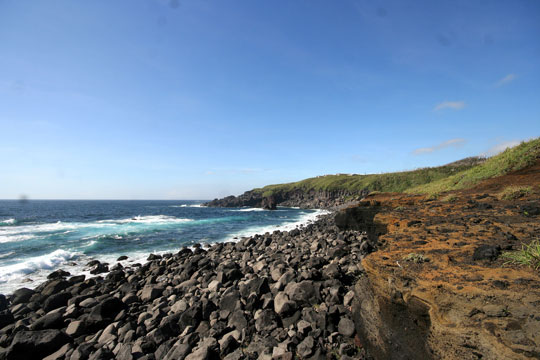
| Nearest Bus stop: | Toga-Jinja mae |
| Necessary Time: | at least one hour |
| Notes: | Lavatory available in front of the shrine |
This site is located in the southwest of the island. A forest of the huge TABUNOKI, which had thrived around the shrine before, died off from the volcanic gas by the eruptions in 2000.
On the grass at Toga-hama, you will be able to see Pleske’s Grasshopper-warbler from spring to summer. From Mahana, a cape next to Toga-hama, you can see offshore Streaked Shearwater as well as Brown Booby KATSUODORI Sula leucogaster and Japanese Murrelet occasionally.
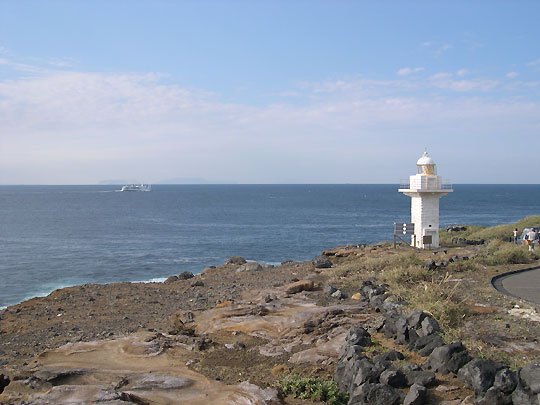
| Nearest Bus stop: | Izumisaki iriguchi |
| Necessary Time: | at least 2 hours |
| Notes: | Lavatory and rest station available |
This site is located in the northwest of the island. The grass area near the white lighthouse is one of the world’s most important and rarest habitats for Pleske’s Grasshopper-warbler. The best birdwatching season is from May to July.
During migration seasons in spring and autumn, a lot of birds including waders pass through the site. Seabirds such as Streaked Shearwater can also be seen offshore.
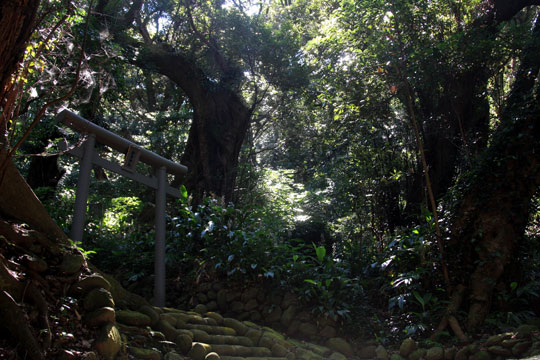
| Nearest Bus stop: | Yakushi-mae- |
| Necessary Time: | about one hour |
| Notes: | Lavatory and resting places unavailable |
This site is located in the northwest of the island. This is an important site where you can easily see a subspecies of Winter Wren endemic to the Izushoto islands.
As soon as you enter the temple grounds , you will see Izu Thrush, Izu Leaf-warbler, subspecies of Varied Tit and Japanese White-eye. In the dense forest, where the huge SUDAJII covers the path, you can often see subspecies of Winter Wren and that of Japanese Robin. A small temple is at the end of the path, a few hundreds meters away. A lot of Japanese Wood Pigeons occur here.
Between April and June, you can watch alcids including Japanese Murrelet, shearwaters, skuas, phalaropes and petrels from the ship which leaves Miyakejima in the afternoon for Tokyo.